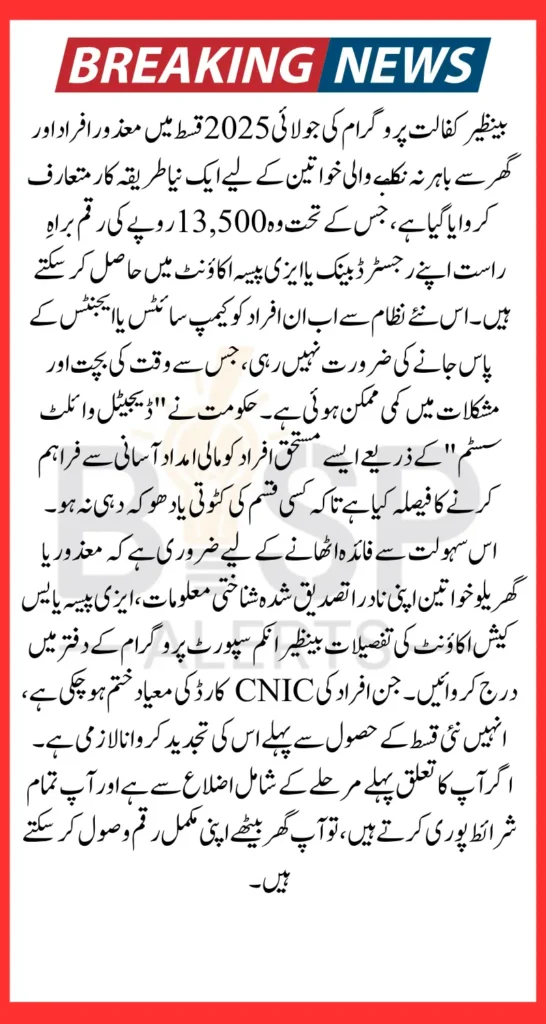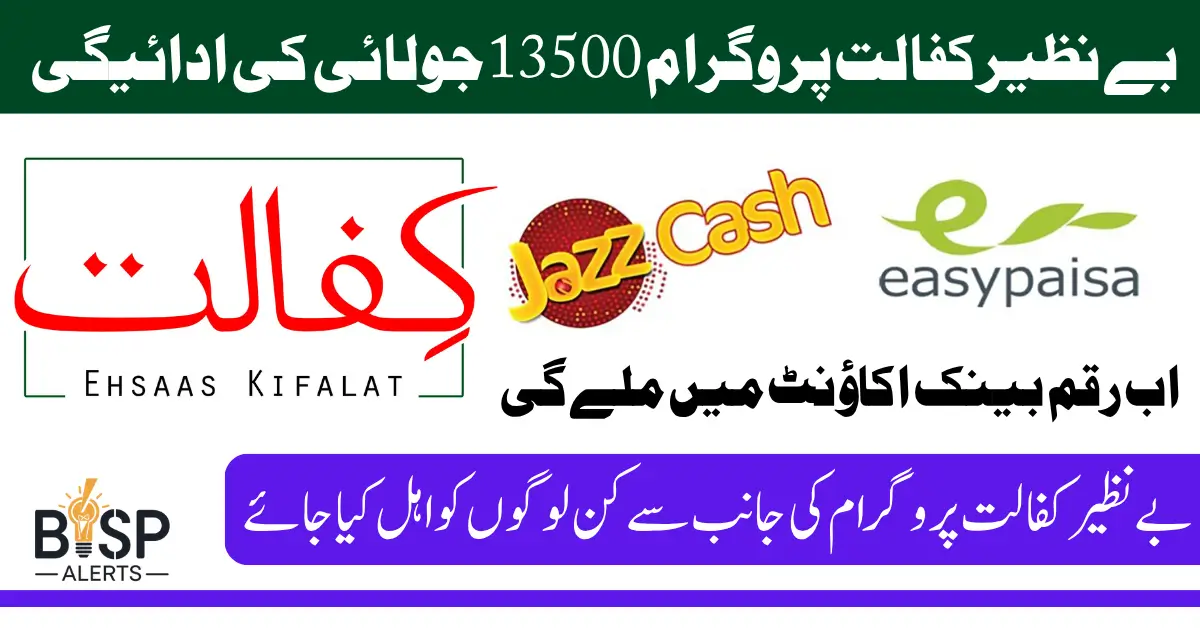Benazir Kafalat Program July Payments
Benazir Kafalat Program July Payments continues to provide critical financial support to low-income families across Pakistan. In July 2025, the government has introduced a major update to the payment system that directly benefits disabled persons and homebound women. For the first time, a dedicated and inclusive withdrawal process has been put in place to ensure that beneficiaries who cannot physically reach campsites or agents can still access their full payments with dignity and convenience. This article explains everything you need to know about the new withdrawal process, eligibility, and how to register for digital payment options.

The first phase of the July 2025 installment has officially begun and includes 49 districts from all provinces, Gilgit-Baltistan, and Azad Jammu & Kashmir. This phase is unique because of the multiple payment delivery channels that have been introduced to ease the pressure on camps and reduce long queues. Eligible women, particularly those with disabilities or other mobility issues, can now receive their Rs. 13,500 installment directly in their registered bank accounts. This change not only brings convenience but also ensures safety and transparency in fund disbursement.
You Can Also Read: 8171 Web Portal CNIC Confirmation
Updates in the July 2025 Benazir Kafalat Payment Cycle
To reduce stress on collection points and improve access for all women, the government has made several significant changes to the Benazir Kafalat distribution system:
- Payments are now being made through:
- Government-assigned campsites
- HBL Konnect agents
- Selected bank branches
- ATM withdrawals have been restored in some cities for added convenience
- A real-time monitoring system is now active to reduce fraud and crowding
- Phase 1 began on Thursday and Friday of launch week
These updates were necessary due to the complaints received during previous phases, especially from rural areas where women had to travel far or wait for hours to collect their money. Now, efforts have been made to ensure no single distribution point is overloaded and all beneficiaries are served quickly and safely.
You Can Also Read: 8171 Validation To Check BISP 13500 Payment
New Withdrawal Process for Disabled and Homebound Women
One of the most appreciated changes in the July 2025 payment cycle is the newly introduced special withdrawal process for disabled persons and veiled women who are unable to visit payment centers. The government has launched a system where such beneficiaries can register their bank account details with BISP—particularly Easypaisa or Yes Cash accounts—and receive the full amount directly into their accounts without needing to leave their homes.
This initiative is a game-changer for thousands of women and individuals who were previously dependent on others or forced to take risks just to collect their payments. With the new digital system, the process is now not only more secure but also aligned with modern banking practices.
You Can Also Read: Benazir Kafalat Phase 1 Payments July Distribution
How the Digital Violet Benazir Kafalat Payment System Works
Under the Digital Violet system, qualified individuals will receive their payments directly into their mobile wallets or bank accounts. This system ensures that money reaches the rightful person without deductions, delays, or physical barriers. Once the account is verified, the payment is processed and can be accessed anytime through ATMs, Easypaisa agents, or digital apps.
For disabled individuals and veiled women, this approach provides both privacy and independence. They no longer need to stand in lines or interact with unknown agents, which reduces the risk of fraud or mistreatment.
You Can Also Read: 8171 BISP Registration Check By CNIC 13500
Eligibility and Registration for Special Payment Method
To benefit from the direct transfer system, a few important conditions must be met:
- You must be registered in the BISP database with a valid CNIC
- Your PMT score must be 32 or below
- You must have completed the NSER survey
- You must be either:
- A disabled individual
- A widow or veiled woman unable to travel
- A homebound person unable to walk or move freely
Once these conditions are met, the next step is to register your bank account Yes Cash or Easypaisa with BISP. This account must be in the name of the beneficiary. Once approved, future installments will be transferred digitally.
You Can Also Read: BISP 13500 Payment New System Launched
Step-by-Step Process to Collect BISP 13500 for Disabled Individuals
To help you navigate the new system, here’s a clear breakdown of the collection process:
- Check Eligibility
- SMS your CNIC to 8171 or visit the 8171 web portal to confirm your status
- Register Your Bank Account
- Submit your Easypaisa or Yes Cash number linked to your CNIC
- Wait for Confirmation
- Once verified, BISP will send your payment directly to the account
- Withdraw Money
- Use mobile banking, ATM, or authorized retailer to collect your funds
- Save the Confirmation Message
- Always keep a record or receipt of the transaction for your safety
You Can Also Read: BISP 8171 Web Portal For Check June Payment 13500
Important Points to Keep in Mind
Although the new process is designed to simplify payments, you should still be cautious and follow a few essential rules:
- Ensure your CNIC is valid—an expired CNIC means you will not receive payment
- Do not pay any agent or allow anyone to deduct from your amount
- Never share your CNIC number with unauthorized persons
- Report fraud or deductions immediately by messaging 8171
- If your district is not in Phase 1, wait for the announcement of Phase 2 which is expected soon
These rules help protect you and ensure you get your rightful payment without any interference or fraud.
Districts Included in Phase 1 of July 2025
In total, 49 districts have been selected for the first round of payments. These include key areas from Punjab, Sindh, Balochistan, KPK, GB, and AJK. Here are some of the major districts included:
- Punjab: Rawalpindi, Islamabad, Sialkot, Multan, Bahawalpur, Mandi Bahauddin
- Sindh: Sanghar, Tharparkar, Mirpur Khas, Dadu, Khairpur
- Balochistan: Zhob, Loralai, Qila Saifullah, Chaman
- KPK: Buner, Lakki Marwat, Tank
- AJK & GB: Ghizer, Haveli
If your area is included, and you meet the eligibility criteria, you can immediately apply for your payment.
You Can Also Read: 8171 Web Portal Payment Verification In Using ID Card
Conclusion
Benazir Kafalat Program July Payments reflects the government’s strong commitment to making the system more inclusive, efficient, and user-friendly. By offering a dedicated withdrawal system for disabled persons and veiled women, the program is ensuring that no eligible citizen is left behind. These improvements not only reduce the risks and challenges previously faced by thousands of women but also promote transparency and convenience.
If you or someone you know is unable to physically collect their payment, it’s time to switch to the digital method. Ensure your documents are up to date, register your bank account, and receive your full Rs. 13,500 without stepping outside. For any updates, rely only on official channels like 8171 and the BISP web portal
You Can Also Read: 8171 CNIC Verification Check Eligibility for BISP 13500
FAQs
Can disabled persons receive BISP payments without visiting a camp?
Yes, disabled individuals can now receive their Rs. 13,500 payment directly through a registered Easypaisa or bank account.
What is the Digital Violet system in the Kafalat program?
It’s a new method that allows eligible homebound women and disabled persons to receive payments digitally in their accounts.
Is biometric verification still needed for disabled individuals?
In most cases, yes, but the verification can be completed at home if mobility is a concern.
Can someone else collect payment on behalf of a disabled person?
No, BISP payments are only given after biometric verification of the actual beneficiary.
How can I register my Easypaisa account for BISP payments?
Visit the nearest BISP office or call the helpline to register your account under your CNIC.
Will this new payment method continue in future phases?
Yes, the government plans to expand digital payments for disabled persons in upcoming phases too.
